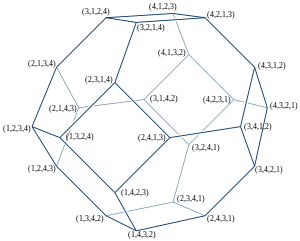Truncated octahedron
| Truncated octahedron | |
|---|---|
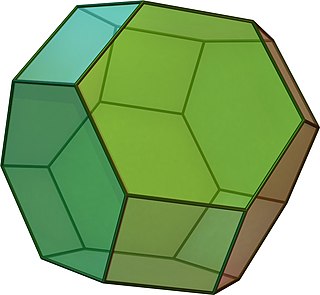 (Click here for rotating model) | |
| Type | Archimedean solid Uniform polyhedron |
| Elements | F = 14, E = 36, V = 24 (χ = 2) |
| Faces by sides | 6{4}+8{6} |
| Conway notation | tO bT |
| Schläfli symbols | t{3,4} tr{3,3} or |
| t0,1{3,4} or t0,1,2{3,3} | |
| Wythoff symbol | 2 4 | 3 3 3 2 | |
Coxeter diagram |
|
| Symmetry group | Oh, B3, [4,3], (*432), order 48 Th, [3,3] and (*332), order 24 |
| Rotation group | O, [4,3]+, (432), order 24 |
| Dihedral angle | |
| References | U08, C20, W7 |
| Properties | Semiregular |
 Colored faces |
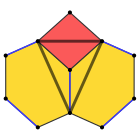 4.6.6 (Vertex figure) |
 Tetrakis hexahedron (dual polyhedron) |
 Net |

In
The truncated octahedron was called the "mecon" by Buckminster Fuller.[1]
Its dual polyhedron is the tetrakis hexahedron. If the original truncated octahedron has unit edge length, its dual tetrakis hexahedron has edge lengths 9/8√2 and 3/2√2.
Construction

|

|
A truncated octahedron is constructed from a regular octahedron with side length 3a by the removal of six right square pyramids, one from each point. These pyramids have both base side length (a) and lateral side length (e) of a, to form equilateral triangles. The base area is then a2. Note that this shape is exactly similar to half an octahedron or Johnson solid J1.
From the properties of square pyramids, we can now find the slant height, s, and the height, h, of the pyramid:
The volume, V, of the pyramid is given by:
Because six pyramids are removed by truncation, there is a total lost volume of √2a3.
Orthogonal projections
The truncated octahedron has five special
| Centered by | Vertex | Edge 4-6 |
Edge 6-6 |
Face Square |
Face Hexagon |
|---|---|---|---|---|---|
| Solid | 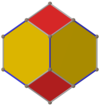
|
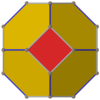
|

| ||
| Wireframe | 
|

|

|

|
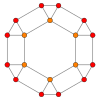
|
| Dual | 
|
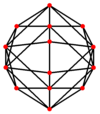
|

|
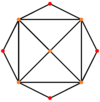
|

|
| Projective symmetry |
[2] | [2] | [2] | [4] | [6] |
Spherical tiling
The truncated octahedron can also be represented as a

|
 square-centered |
 hexagon-centered |
| Orthographic projection | Stereographic projections | |
|---|---|---|
Coordinates

|

|

|
bounding box (±2,±2,±2) |
Truncated octahedron with hexagons replaced by 6 coplanar triangles. There are 8 new vertices at: (±1,±1,±1). | Truncated octahedron subdivided into as a topological rhombic triacontahedron |
All
of edge length a = √2 centered at the origin. The vertices are thus also the corners of 12 rectangles whose long edges are parallel to the coordinate axes.The
Dissection
The truncated octahedron can be dissected into a central octahedron, surrounded by 8 triangular cupolae on each face, and 6 square pyramids above the vertices.[2]
Removing the central octahedron and 2 or 4 triangular cupolae creates two
| Genus 2 | Genus 3 |
|---|---|
D3d , [2+,6], (2*3), order 12
|
Td, [3,3], (*332), order 24 |

|

|
Permutohedron
The truncated octahedron can also be represented by even more symmetric coordinates in four dimensions: all permutations of (1, 2, 3, 4) form the vertices of a truncated octahedron in the three-dimensional subspace x + y + z + w = 10. Therefore, the truncated octahedron is the permutohedron of order 4: each vertex corresponds to a permutation of (1, 2, 3, 4) and each edge represents a single pairwise swap of two elements.
Area and volume
The surface area S and the volume V of a truncated octahedron of edge length a are:
Uniform colorings
There are two
| 1-uniform | 2-uniform | ||
|---|---|---|---|
| Oh, [4,3], (*432) Order 48 |
Td, [3,3], (*332) Order 24 |
D4h, [4,2], (*422) Order 16 |
D3d, [2+,6], (2*3) Order 12 |
 122 coloring |
 123 coloring |
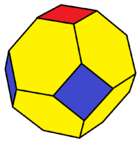 122 & 322 colorings |
 122 & 123 colorings |
| Truncated octahedron (tO) |
Bevelled tetrahedron (bT) |
Truncated square bipyramid (tdP4) |
Truncated triangular antiprism (tA3) |
Chemistry
The truncated octahedron exists in the structure of the faujasite crystals.
Data hiding
The truncated octahedron (in fact, the generalized truncated octahedron) appears in the error analysis of quantization index modulation (QIM) in conjunction with repetition coding.[3]
Related polyhedra
The truncated octahedron is one of a family of uniform polyhedra related to the cube and regular octahedron.
| Uniform octahedral polyhedra | ||||||||||
|---|---|---|---|---|---|---|---|---|---|---|
| Symmetry: [4,3], (*432) | [4,3]+ (432) |
[1+,4,3] = [3,3] (*332) |
[3+,4] (3*2)
| |||||||
| {4,3} | t{4,3} | r{4,3} r{31,1} |
t{3,4} t{31,1} |
{3,4} {31,1} |
rr{4,3} s2{3,4} |
tr{4,3} | sr{4,3} | h{4,3} {3,3} |
h2{4,3} t{3,3} |
s{3,4} s{31,1} |
= |
= |
= |
||||||||
| Duals to uniform polyhedra | ||||||||||
| V43 | V3.82 | V(3.4)2 | V4.62 | V34 | V3.43 | V4.6.8 | V34.4 | V33 | V3.62 | V35
|
It also exists as the omnitruncate of the tetrahedron family:
| Family of uniform tetrahedral polyhedra | |||||||
|---|---|---|---|---|---|---|---|
| Symmetry: [3,3], (*332) | [3,3]+, (332) | ||||||

|

|

|

|
||||
| {3,3} | t{3,3} | r{3,3} | t{3,3} | {3,3} | rr{3,3} | tr{3,3} | sr{3,3}
|
| Duals to uniform polyhedra | |||||||

|

|

|

| ||||
| V3.3.3 | V3.6.6 | V3.3.3.3 | V3.6.6 | V3.3.3 | V3.4.3.4 | V4.6.6 | V3.3.3.3.3
|
Symmetry mutations
| *n32 symmetry mutation of omnitruncated tilings: 4.6.2n | ||||||||||||
|---|---|---|---|---|---|---|---|---|---|---|---|---|
| Sym. *n32 [n,3] |
Spherical | Euclid. | Compact hyperb. | Paraco. | Noncompact hyperbolic | |||||||
| *232 [2,3] |
*332 [3,3] |
*432 [4,3] |
*532 [5,3] |
*632 [6,3] |
*732 [7,3] |
*832 [8,3] |
*∞32 [∞,3] |
[12i,3] |
[9i,3] |
[6i,3] |
[3i,3] | |
| Figures | 
|

|

|

|

|

|

|

|

|

|

| |
| Config. | 4.6.4 | 4.6.6 | 4.6.8 | 4.6.10 | 4.6.12 | 4.6.14 | 4.6.16 | 4.6.∞ | 4.6.24i | 4.6.18i | 4.6.12i | 4.6.6i |
| Duals | 
|

|

|

|

|

|

|

|

|

|

|

|
Config.
|
V4.6.4 | V4.6.6 | V4.6.8 | V4.6.10 | V4.6.12
|
V4.6.14
|
V4.6.16
|
V4.6.∞ | V4.6.24i | V4.6.18i | V4.6.12i | V4.6.6i |
| *nn2 symmetry mutations of omnitruncated tilings: 4.2n.2n | ||||||||||||||
|---|---|---|---|---|---|---|---|---|---|---|---|---|---|---|
| Symmetry *nn2 [n,n] |
Spherical | Euclidean | Compact hyperbolic | Paracomp. | ||||||||||
| *222 [2,2] |
*332 [3,3] |
*442 [4,4] |
*552 [5,5] |
*662 [6,6] |
*772 [7,7] |
*882 [8,8]... |
*∞∞2 [∞,∞] | |||||||
| Figure | 
|

|

|

|

|

|

|

| ||||||
| Config. | 4.4.4
|
4.6.6 | 4.8.8 | 4.10.10 | 4.12.12 | 4.14.14 | 4.16.16 | 4.∞.∞ | ||||||
| Dual | 
|

|

|

|

|

|

|

| ||||||
Config.
|
V4.4.4 | V4.6.6
|
V4.8.8 | V4.10.10 | V4.12.12 | V4.14.14 | V4.16.16 | V4.∞.∞ | ||||||
This polyhedron is a member of a sequence of uniform patterns with vertex figure (4.6.2p) and
The truncated octahedron is topologically related as a part of sequence of uniform polyhedra and tilings with
| *n32 symmetry mutation of truncated tilings: n.6.6 | ||||||||||||
|---|---|---|---|---|---|---|---|---|---|---|---|---|
| Sym. *n42 [n,3] |
Spherical | Euclid. | Compact | Parac. | Noncompact hyperbolic | |||||||
| *232 [2,3] |
*332 [3,3] |
*432 [4,3] |
*532 [5,3] |
*632 [6,3] |
*732 [7,3] |
*832 [8,3]... |
*∞32 [∞,3] |
[12i,3] | [9i,3] | [6i,3] | ||
| Truncated figures |

|

|

|

|

|

|

|

|

|

|

| |
| Config. | 2.6.6 | 3.6.6 | 4.6.6 | 5.6.6 | 6.6.6 | 7.6.6 | 8.6.6 | ∞.6.6 | 12i.6.6 | 9i.6.6 | 6i.6.6 | |
| n-kis figures |

|

|

|

|

|

|

|

|
||||
Config.
|
V2.6.6 | V3.6.6 | V4.6.6 | V5.6.6 | V6.6.6
|
V7.6.6 | V8.6.6 | V∞.6.6 | V12i.6.6 | V9i.6.6 | V6i.6.6 | |
The truncated octahedron is topologically related as a part of sequence of uniform polyhedra and tilings with
| *n42 symmetry mutation of truncated tilings: 4.2n.2n | |||||||||||
|---|---|---|---|---|---|---|---|---|---|---|---|
| Symmetry *n42 [n,4] |
Spherical | Euclidean | Compact hyperbolic | Paracomp. | |||||||
| *242 [2,4] |
*342 [3,4] |
*442 [4,4] |
*542 [5,4] |
*642 [6,4] |
*742 [7,4] |
*842 [8,4]... |
*∞42 [∞,4] | ||||
| Truncated figures |

|

|

|

|

|

|

|

| |||
| Config. | 4.4.4 | 4.6.6 | 4.8.8 | 4.10.10 | 4.12.12 | 4.14.14 | 4.16.16 | 4.∞.∞ | |||
| n-kis figures |

|

|

|

|

|

|

|

| |||
Config.
|
V4.4.4 | V4.6.6
|
V4.8.8 | V4.10.10 | V4.12.12 | V4.14.14 | V4.16.16 | V4.∞.∞ | |||
Related polytopes
The truncated octahedron (bitruncated cube), is first in a sequence of bitruncated hypercubes:
| Image |  
|
 
|
 
|
 
|
 
|
 
|
... |
|---|---|---|---|---|---|---|---|
| Name | Bitruncated cube | Bitruncated tesseract
|
Bitruncated 5-cube
|
Bitruncated 6-cube
|
Bitruncated 7-cube
|
Bitruncated 8-cube
| |
| Coxeter | |||||||
| Vertex figure |  ( )v{ } |
 { }v{ } |
 { }v{3} |
 { }v{3,3} |
{ }v{3,3,3} | { }v{3,3,3,3} |
It is possible to slice a tesseract by a hyperplane so that its sliced cross-section is a truncated octahedron.[4]
Tessellations
The truncated octahedron exists in three different convex uniform honeycombs (space-filling tessellations):
| Bitruncated cubic | Cantitruncated cubic
|
Truncated alternated cubic
|
|---|---|---|

|

|
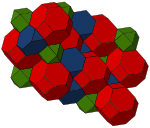
|
The
Objects
-
ancient Chinese die
-
sculpture in Bonn
-
Rubik's Cube variant
-
model made with Polydron construction set
-
Pyrite crystal
-
Boleite crystal
Truncated octahedral graph
| Truncated octahedral graph | |
|---|---|
Hamiltonian, regular, zero-symmetric | |
| Table of graphs and parameters |
In the
As a

References
- ^ "Truncated Octahedron". Wolfram Mathworld.
- ^ Doskey, Alex. "Adventures Among the Toroids – Chapter 5 – Simplest (R)(A)(Q)(T) Toroids of genus p=1". www.doskey.com.
- .
- MR 2561378
- ^ Read, R. C.; Wilson, R. J. (1998), An Atlas of Graphs, Oxford University Press, p. 269
- ^ Wolz, Jessica; Engineering Linear Layouts with SAT. Master Thesis, University of Tübingen, 2018
- ^ Weisstein, Eric W. "Truncated octahedral graph". MathWorld.
- ISBN 0-486-23729-X. (Section 3–9)
- Freitas, Robert A. Jr (1999). "Figure 5.5: Uniform space-filling using only truncated octahedra". Nanomedicine, Volume I: Basic Capabilities. Georgetown, Texas: Landes Bioscience. Retrieved 2006-09-08.
- Gaiha, P. & Guha, S.K. (1977). "Adjacent vertices on a permutohedron". SIAM Journal on Applied Mathematics. 32 (2): 323–327. doi:10.1137/0132025.
- Hart, George W. "VRML model of truncated octahedron". Virtual Polyhedra: The Encyclopedia of Polyhedra. Retrieved 2006-09-08.
- Mäder, Roman. "The Uniform Polyhedra: Truncated Octahedron". Retrieved 2006-09-08.
- Alexandrov, A.D. (1958). ISBN 3-540-23158-7.
- Cromwell, P. (1997). Polyhedra. United Kingdom: Cambridge. pp. 79–86 Archimedean solids. ISBN 0-521-55432-2.





